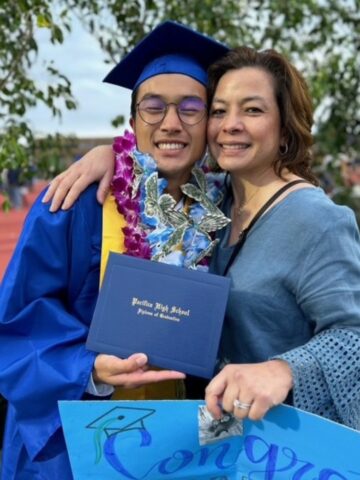CHOC’s multidisciplinary team used laser interstitial thermal therapy (LITT) — one of several minimally invasive treatments shaping the present and future of pediatric neuro-oncology and pediatric neurosurgery — to treat recurrent medulloblastoma in a young patient as an alternative to standard-of-care surgical resection. A year after the procedure, the patient showed significant reduction in tumor size and enhancement.
“Up to 30% of patients have recurrence of medulloblastoma,” says Dr. Chenue Abongwa, pediatric neuro-oncologist at the Hyundai Cancer Institute at CHOC. “In those situations, less than 25% survive, which is a challenge because we are always looking for ways to improve treatment for patients with recurrent disease who have undergone extensive treatment and are dealing with complications of treatment.”
The benefits of laser ablation
While the outlook for medulloblastoma is bleak — survival rates have stagnated in the last two decades, while survivors tend to have poor quality of life — LITT holds out hope for both prolonged survival and improved outcomes. The procedure is still relatively rare, but increasingly, clinicians are turning to LITT to treat certain recurrent medulloblastomas and similar malignancies. Ideal candidates include patients with small — a circumference of 3 centimeters or less — focal lesions situated deep in the brain for whom resection via craniotomy is not optimal or desirable.
“With LITT, we make a small, 5-millimeter incision and stereotactically insert a probe to the location of the lesion,” says Dr. Joffre Olaya, pediatric neurosurgeon at the CHOC Neuroscience Institute. “We use a laser to ablate the tumor under direct MRI visualization. Ablating the tumor is comparable to resecting it, but without having to perform a craniotomy.”
A robotic stereotactic assistance device allows pediatric neurosurgeons to precisely target tumors without damaging surrounding brain tissue or vasculature. Typically, the surgeon will conduct a concurrent biopsy of the tumor.
“Our patients have tolerated LITT quite well,” Dr. Olaya says. “Most return home the day after the procedure and have minimal pain. Recovery is much quicker than with a standard craniotomy.”
Dr. Olaya also values the flexibility that LITT affords.
“LITT does not eliminate the option of standard resection,” he says. “If a tumor continues to grow or spread after a patient undergoes LITT, we can always go back and perform a standard craniotomy.”
LITT for a patient with recurrent medulloblastoma and posterior fossa syndrome
Dr. Abongwa and Dr. Olaya were part of a multidisciplinary team that used LITT to treat an 11-year-old patient who developed posterior fossa syndrome after undergoing initial medulloblastoma treatment — consisting of gross total resection followed by chemotherapy and radiation therapy — years earlier and had a recurrence of the brain tumor.
“This case is an excellent illustration of when we can use laser ablation,” Dr. Abongwa says. “The patient had undergone standard treatment for medulloblastoma at age 5, developed significant complications as a result, then had a recurrence. Surgery was not a good option because the family was worried about the patient’s quality of life and the potential for more problems after another craniotomy.”
As with all pediatric brain tumor cases at CHOC, the case was presented to the biweekly neuro-oncology tumor board comprised of pediatric neurosurgeons, pediatric neuroradiologists, a pediatric neuro-oncologist, pediatric neurologists and pediatric endocrinologists. The group discussed the patient’s case and determined LITT would be appropriate.
“We evaluated the patient based on their situation and found that LITT would be a good option to help us control the tumor locally without increasing the chances of the patient experiencing problems related to treatment,” Dr. Abongwa says. “The patient tolerated the treatment well.”
After undergoing LITT, the patient began receiving standard chemotherapy treatment for tumor control. That regimen continues, but after a year of surveillance, no signs of tumor recurrence have emerged.
“LITT offers a less invasive method that may serve as an adjunct in treating recurrent tumors, or, potentially, as palliation,” Dr. Olaya says. “Some patients have recurrent tumors that cause symptoms, but we may not want to put them through an initial major surgery. From a palliative standpoint, LITT may help improve their quality of life and extend life in these situations without having to put these children through a craniotomy.”
Growing applications
Clinicians need more long-term follow-up data for patients treated with LITT. That is why CHOC is participating in Laser Ablation of Abnormal Neurological Tissue Using Robotic Neuroblate System (LAANTERN), a prospective, multicenter registry that collects safety, quality of life, and outcomes and survival data on up to 1,000 patients for up to five years. This data will help clinicians better understand the efficacy of LITT compared with standard treatment.
Recent research supports the use of LITT to treat newly diagnosed tumors, such as low-grade gliomas, according to Dr. Abongwa, but data from large clinical trials are necessary to justify widespread adoption. In the meantime, CHOC continues to seek ways to enhance patient care.
“CHOC is dynamic,” Dr. Abongwa says. “We are always trying to improve the care of children by offering standard treatments and new, innovative therapies that can improve the chance of a cure.”




